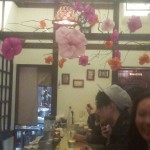WIT Life #262: 梅祭り!
WIT Life is a periodic series written by professional Writer/Interpreter/Translator Stacy Smith (Kumamoto-ken CIR, 2000-03). She starts her day by watching Fujisankei’s newscast in Japanese, and here she shares some of the interesting tidbits and trends along with her own observations.
Over the weekend I had the chance to try the 梅祭り (ume matsuri or plum blossom festival) Prix Fixe at Hi Collar in the East Village. It was my first time going to this cool hole-in-the-wall location, which hasn’t even been open for a year. Hi Collar operates as a coffee shop during the day, offering beverages and desserts, and at night transforms into a sake bar/restaurant. You can see some of the amazing ume offerings in the menu here, and I especially enjoyed the rice that closed the meal (although it lacked yuba which is one of my favorite foods, as they had run out). The cozy bar sits about 10 people (and has little hooks for your bags underneath, so convenient!), and we were there on Saturday night so it was packed. However, there is a turnover as some people just come in for a drink and leave fairly quickly, as opposed to people like my friend and I who lingered over our ume course for hours. At $38 it is amazingly reasonable so if you have a chance to go before the end of the month when the matsuri ends I would highly recommend it…
I also got the accompanying $30 Umeshu Pairing, which was phenomenal. It came with five glasses of various 梅酒 (ume shu or plum wine), not all of which were sweet. I really liked the Kimoto Umeshu from Daishichi Brewery in Fukushima. This sake producer was one of a few highlighted in a recent New York Times article about how the Japan government is using sake to revitalize the economy by promoting this drink along with other softer goods such as anime, music, fashion and food as part of the Cool Japan program. As the article notes, “Sake producers in Fukushima are suffering even more than their peers elsewhere in Japan, rocked not just by the downturn in domestic consumption but also by fears over safety, after the accident at the Fukushima Daiichi nuclear power plant in March 2011.” Good to know that one way you can help the Tohoku area affected by the earthquake and tsunami, with the three-year anniversary soon approaching, is to opt for sake produced there!


Comments are closed.